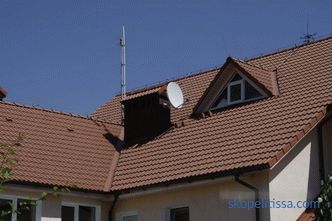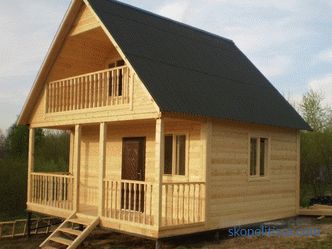Street lighting has long been no longer just a way to dispel evening twilight and the darkness of the night - it has become an integral element of landscape design, responsible for creating an atmosphere of comfort and convenience. In addition, the lighting of the plot of a country house at night allows you to secure movement in the cottage and the surrounding area.
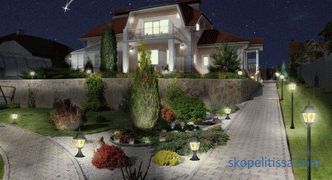
Being properly designed and technically correctly implemented, the street lighting of the site and outdoor buildings (including the cottage itself) greatly facilitates orientation in the territory and emphasizes the individuality of the household. However, one should not think that it is a simple task for non-professionals to plan and organically integrate the outdoor lighting system into the existing engineering systems at home.
Requirements to be met by lighting
A properly designed lighting system for a house and a plot should perform several complementary functions at once, which determine the requirements for outdoor advertising. In fact, there are only two mandatory conditions for outdoor lighting: low-voltage power supply (no more than 36 V, usually 12 V) and the corresponding protection level of luminaires (no less than IP45).
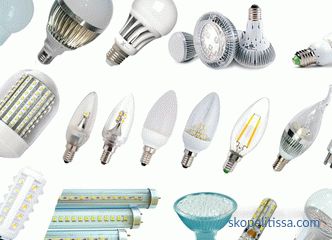
There are no other defined strict standards for such systems, but no one has canceled common sense. And according to him, the outdoor lighting of the house should have the following characteristics:
-
to maintain performance in all weather conditions;
-
to be as simple and convenient to manage;
-
do not require complicated maintenance during operation;
-
blend in harmoniously with the surrounding landscape;
-
do not act annoyingly on human vision;
-
be economical in terms of power consumption.
The lighting should always work
The validity of the first statement is obvious: the climatic conditions in our country are such that the exterior lighting of the house must perform its functional duties uninterruptedly as during heat in three four dozen degrees, and being under a half-meter layer of snow. ..
The street lighting system includes wired lines, light emitters, outdoor sensors and controls. Of all the above, only control units - switches and controllers - can be installed and subsequently operated in a comfortable home environment.
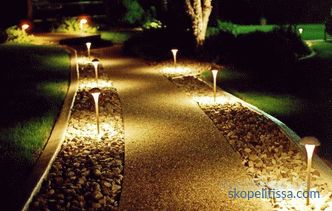
That is why the choice of suitable equipment and components for outdoor lighting systems is quite a challenge even for professionals. Indeed, in some cases, even the quality of the material from which the fasteners are made is important!
On our site you can familiarize yourself with the most popular projects of houses from construction companies represented at the exhibition “Low-Rise Country”.
Ease of operation
The requirements for the simplicity of controlling the exterior lighting system are due to the need to eliminate the human factor - which can lead to unpredictable consequences of unprofessional interference with the well-functioning, technically complex system. And it is precisely this - one of the reasons why lighting on a section of a country house is always designed so that the failure of one of the controls does not lead to a malfunction of the entire outdoor unit as a whole.
If necessary, street lighting can be created as one of the elements of a “smart home” - that is, it can be fully automated, but with the possibility of rapid manual intervention in control.
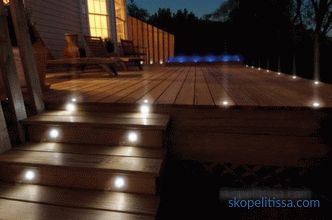
In this case, the simplicity of control is maximum, and all the features of the system are revealed most fully - however, this is the most expensive lighting option.
Features of maintenance of lighting lines
The complexity of maintenance is determined not by the complexity of the lighting system itself, but by the degree of technical perfection of its components. The weakest links here are cables (wires) and motion or light sensors.In almost 100% of cases, LED devices are used as light sources - today only they guarantee reliable operation regardless of the surrounding atmospheric and temperature conditions.
With regard to power lines, the situation is somewhat different - a lot depends not only (and not so much) on the quality of cable products, but on the method of its installation. In fact, there are only two: open and closed gasket.
Open laying
In the first case, the wires are open-air throughout the entire life of the system and, even with the highest quality insulation, only serve a few seasons. Nevertheless, access to them is extremely simple, and the speed of repair and replacement of faulty areas is maximum.
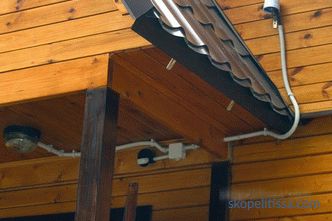
However, with the open method of wiring a power line it is extremely difficult to organically fit into the surrounding landscape .
In the case of organizing lighting in a small area, this method is often the most acceptable both from a technical and financial point of view - but it is practically unacceptable when covering the territory with low ground lights.
On our website you can find contacts of construction companies that offer the service of electrical houses. Directly to communicate with representatives, you can visit the exhibition of houses "Low-rise Country".
Closed laying
With the type of wiring closed, all wires are laid in trenches dug out in the ground, which are subsequently buried; wires that must be above ground level are masked in all possible ways. For additional protection, cable lines are “charged” into corrugated or smooth pipes, which, in turn, can be placed in special trays. The integrity of the landscape with this method of laying is preserved completely, the entire period of operation of the cables and wires are in quite comfortable conditions for them - however, access to them is extremely difficult, and in some cases completely impossible.
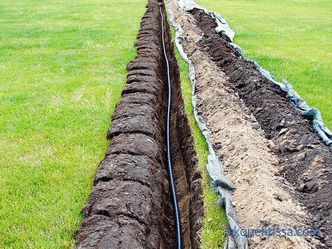
However, when covering large areas, this is the best way to draw lines power supply. In addition, it is universal - underground lines can supply power to lamps located at any height.
But the difficulty of maintenance, oddly, is higher in the case of an open gasket - this is due to the relatively large height of the wire pulling and, in some cases, the difficulty of accessing it.
Outdoor lighting should not be annoying.
The organic inclusion of outdoor lighting in landscape design means that it should not be intrusive and annoying - although some of its elements may well be dramatic and eye-catching. But in any case, the correct lighting of the house and the site must meet the criterion of optimality: a solid bright light, leaving no dark corner, good only at the state border and in the operating room.
It is for this reason that outdoor lighting should be designed simultaneously with the development of the backyard landscape - to “fit” in the already established landscape so that it looks naturally much more difficult. And much more expensive. .. For example, such illumination of a section of a country house will not be cheap, the photo represents the option of illuminating a stone platform near the pool:
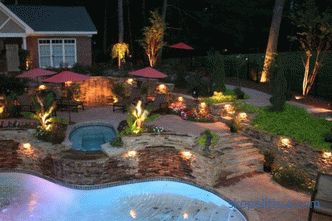
It might be interesting! In the article on the following link read about electrical wiring in a wooden house.
Functionality and decorativeness of area lighting
When developing a general scheme of illumination, both existing types of lighting are usually included in the project - functional and decorative. The task of the first of them is to ensure the comfort of movement on the territory and reduce the possibility of unauthorized contact with it by unauthorized persons. But the task that the decorative lighting of the house solves is to give the buildings and the estate as a whole individuality. For this, a variety of effects and techniques can be used - for example, a contour illumination of a building, accented illumination of bushes and trees, illumination of water bodies.
As the light sources for creating decorative lighting, LED spotlights or ribbons are most often used, and a little less often, various garlands made up of LED emitters. Moreover, monochrome LEDs are rarely used - RGB arrays that allow you to choose any color of light give much more possibilities.
See an example of functional lighting in the local area in the video:
A little about the efficiency of outdoor lighting
The priority of using LED equipment in outdoor lighting is not accidental: such lighting devices are extremely economical in terms of electricity consumption. For small households, in which the role of the exterior lighting system is played by one or two lamps near the gate and the front door, this is not very important. But for medium and large areas, when several dozens of fixtures are involved in the street lighting system, the “street” electricity consumption can reach several kilowatts per day.
In addition, when using LED emitters, it is sufficient to simply arrange the exterior lighting of the area to which the power supply line is not connected at all. Manufacturers produce a large number of LED-lamps, fully autonomous and powered by solar panels (panels). Many hours of full-scale illumination of the territory they organize quite difficult - however, with small sizes of the illuminated area, the use of such lamps saves a good amount.
A few more examples of lighting on the site and at home, in the following video:
Another reason for creating outdoor lighting systems based on LED emitters is technical ease of implementation for them low-voltage power. With proper creation of the outdoor circuit, in some cases, it is permissible to do the usual 220 V, but for security reasons, in most cases, the supply voltage must still be low-voltage - no more than 36 V.
This can be interesting! In the article on the following link read about the design of the plot of 10 acres.
Complicated simplicity of beauty
Modern high-tech outdoor lighting systems allow you to implement design ideas of any scope without much difficulty - but their development and implementation require a lot of experience. Although in operation such systems are simple, their installation is complex and time consuming, requires access to special equipment and only a professional can competently perform it.

